Sept. 12 to Sept. 18
During the early 1940s, a series of suicides shocked the residents of Changhua County’s Renli Village (仁里村).
After the end of World War II, the village chief led a delegation to Nantou County’s Shoutian Temple (受天宮) and invited one of its three Xuantian Shangdi (玄天上帝, Emperor of the Mysterious Heaven) deities home to suppress the bad energy. It worked, and in 1949, Beixuan Temple (北玄宮) was built in the village after “dividing the incense ” (分香) from Shoutian Temple.
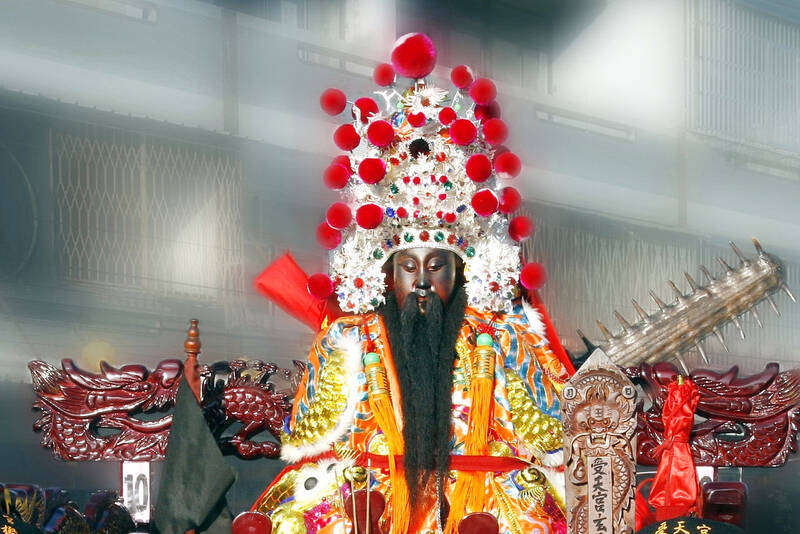
Photo: Hsieh Chieh-yu, Taipei Times
As stories about the power of Shoutian Temple spread, so too did the number of temples receiving incense from it, resulting in a number of branch temples. Sometimes people in need came to the temple, other times the deity appeared to them through spirit mediums or other miraculous feats.
Shoutian Temple was perceived as being so efficacious, that soon branch temples began to split off from other branch temples.
Changhua’s Shouming Temple (受命宮), for example, has numerous branches, all of which still make regular pilgrimages to Shoutian Temple. It’s estimated that between 3,000 and 6,000 personal and public shrines in Taiwan and abroad worship an effigy of Xuantian Shangdi, which was divided from Shoutian Temple.
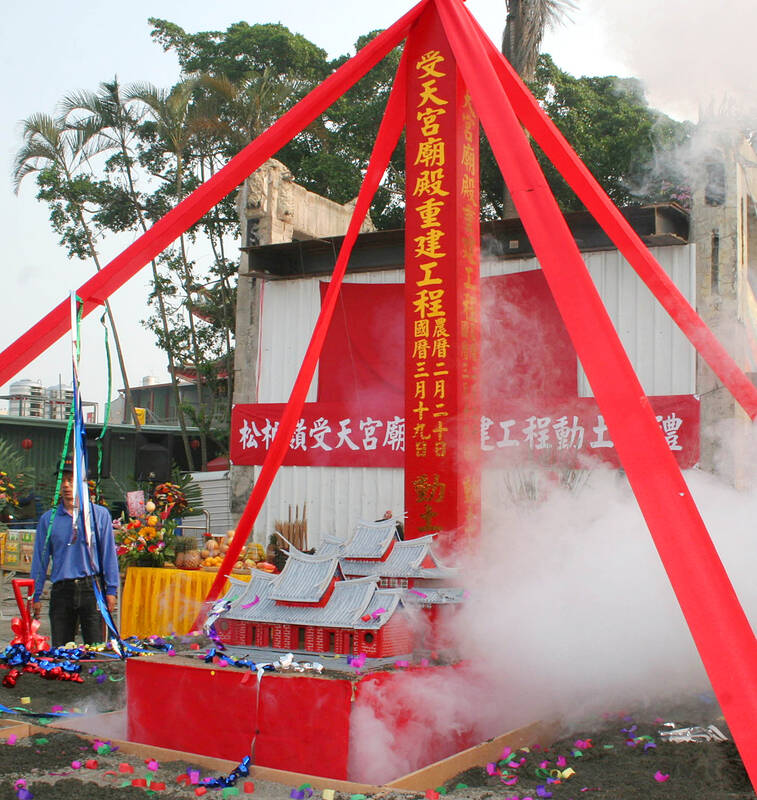
Photo: Hsieh Chieh-yu, Taipei Times
The exact number is unclear because the temple, along with its records, was destroyed in a massive fire in 2000. On Monday, the Liberty Times (Taipei Times’ sister paper) reported that the temple recently set up an online registry and interactive map, hoping that temples that divided its incense from it can add themselves to the list. As of Tuesday, the map shows 846 shrines in Taiwan, four in Malaysia and one each in Vietnam and New Zealand.
FROM OCEAN TO MOUNTAIN
Commanding a divine turtle and snake, Xuantian Shangdi was worshiped in northern China for thousands of years. Waves of immigration brought the deity south to Fujian and Guangdong, and further to Taiwan at the end of the Ming Dynasty.
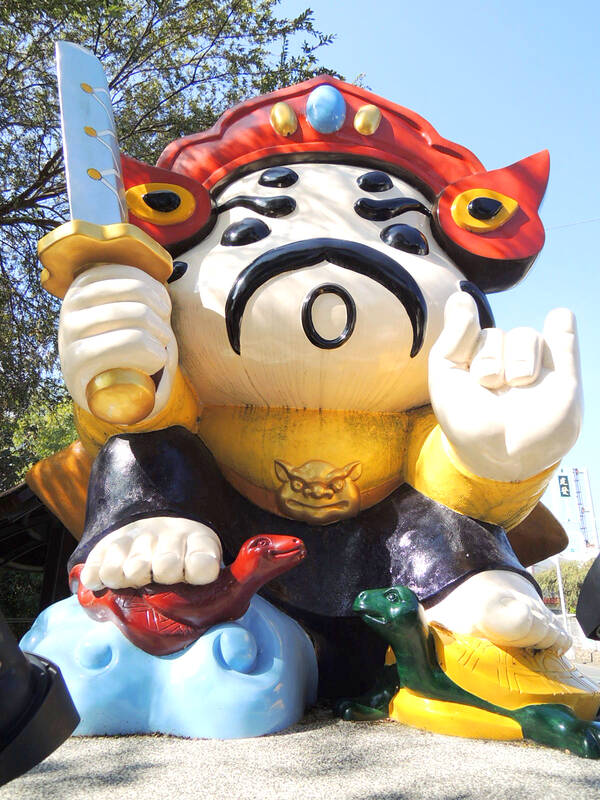
Photo: Hsieh Chieh-yu, Taipei Times
The Ming royal family revered Xuantian Shangdi as the state’s main protector. Since Cheng Cheng-kung (鄭成功, also known as Koxinga) sought to use Taiwan as a base to reclaim China for the Ming, the deity was also popular among his followers in his Tainan-based Kingdom of Tungning.
The Chinese Taoist Xuantian Shangdi Worship Promotion Association (中華道教玄天上帝弘道協會) notes that of the 26 Taoist temples built in Taiwan during Cheng’s reign between 1662 and 1683, seven of them worshiped the Emperor of the Mysterious Heaven as their main deity.
The first iteration of Shoutian Temple was built in 1657 as a crude shack around an incense bag representing the deity by Fujianese immigrants, who settled in the area for its abundant timber and rattan. They eventually abandoned the area. In 1681, nearby residents noticed a bright light coming from the shack. Seeing it as a sign, they built a small shrine to house the deity.
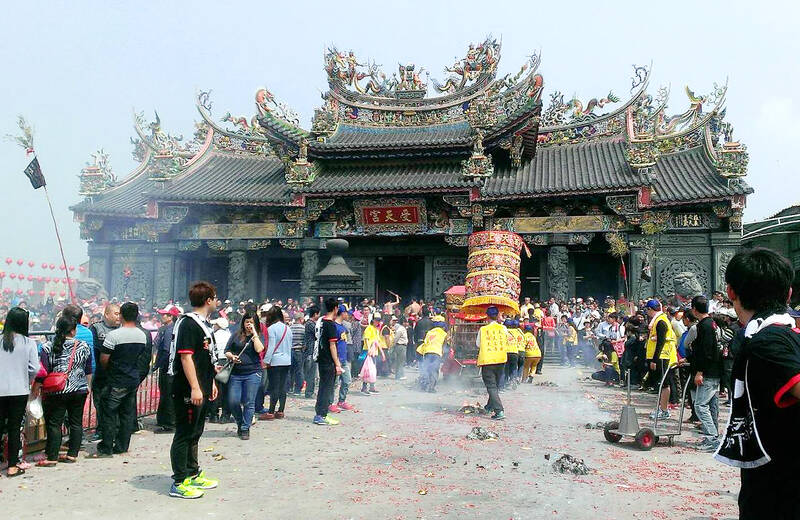
Photo: Hsieh Chieh-yu, Taipei Times
After the Qing Dynasty annexed Taiwan in 1684, they sought to promote the worship of the sea goddess Matsu instead, propagating a legend of her appearing in the Taiwan Strait during the battle to ensure their victory. While the Qing did not outright destroy Xuantian Shangdi temples, the deity’s influence and prestige dropped sharply under their influence.
While Matsu took over as protector of the seas, Xuantian Shangdi temples continued to be worshiped in the mountains. Folklorist Chien Jung-tsung (簡榮聰) posits that the pioneers may have hoped that the emperor’s mastery of reptiles could protect them against the deadly snakes in the hills. He also suggests that later immigrants from Fujian, who retained their devotion to Xuantian Shangdi and mostly settled in mountainous areas, helped these temples thrive.
In 1737, Xuantian Shangdi possessed a spirit medium and instructed locals to build a larger shrine at the current site. He also appeared as an old man with white hair, who commissioned artisans in Lukang to build the temple’s three main effigies in 1745. After they were enshrined, it was officially named Shoutian Temple — literally “receiving the heavens.”
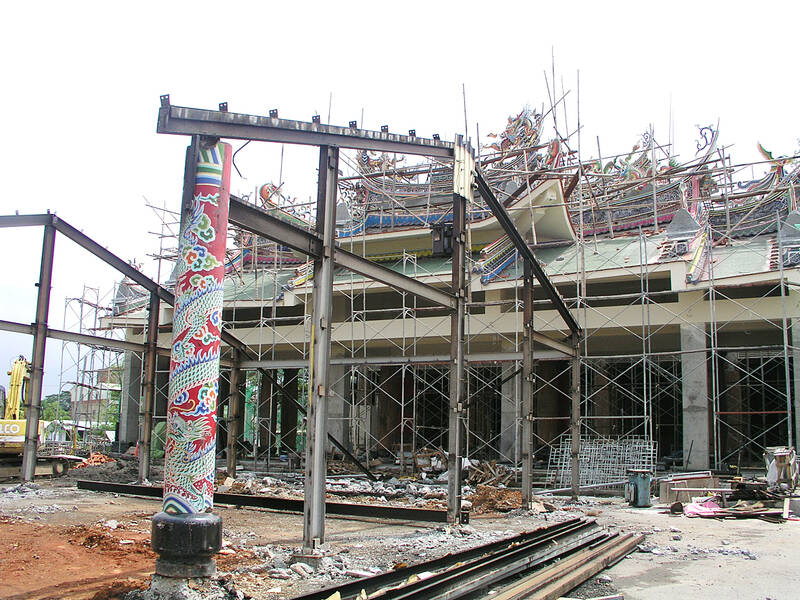
Photo: Hsieh Chieh-yu, Taipei Times
RAPID GROWTH
Despite the Qing’s efforts, Xuantian Shangdi was still the fifth most popular main deity in Taiwan in 1918, with 172 recorded temples dedicated to him. He retained this ranking in a 1981 survey.
In 1846, with the removal of travel restrictions between Taiwan and China, a group of locals headed to Fujian to divide the incense from the original temple. The temple saw a surge in worshippers around that time, leading to significant expansion in 1851, 1887 and 1924. The final expansion before the fire was carried out in 1973.
As the temple’s reputation grew, numerous villages in central Taiwan came to divide its incense, making it the primary Xuantian Shangdi center of worship in the region. But its divisions only grew to its current number and expanded to the rest of the nation after the temple formally established an administrative council in 1953 and management committee in 1957.
Shoutian Temple’s golden years, according to a study by Wen Tsung-han (溫宗翰), was the 1960s and 1970s. Tens of thousands of people, including high ranking officials and influential locals, flocked to the area every 3rd day of the 3rd month of the Lunar calendar, not only to pay their respects but also to enjoy the surrounding scenery and its high quality agricultural products. In 1976, 600 Xuantian Shangdi effigies from across the country were brought there for a 10-day ceremony that garnered much media attention.
The 921 Earthquake devastated Nantou and the surrounding areas in 1999, badly damaging the temple’s columns. Before they could make repairs, a fire the following June completely destroyed the main structure. Worship continued under a makeshift metal structure until the temple was rebuilt in 2008.
The temple continues to expand its influence — its Vietnam division was only established in 2016, for example, and it would be interesting to see how high the number on the map eventually rises to.
Taiwan in Time, a column about Taiwan’s history that is published every Sunday, spotlights important or interesting events around the nation that either have anniversaries this week or are tied to current events.

Most heroes are remembered for the battles they fought. Taiwan’s Black Bat Squadron is remembered for flying into Chinese airspace 838 times between 1953 and 1967, and for the 148 men whose sacrifice bought the intelligence that kept Taiwan secure. Two-thirds of the squadron died carrying out missions most people wouldn’t learn about for another 40 years. The squadron lost 15 aircraft and 148 crew members over those 14 years, making it the deadliest unit in Taiwan’s military history by casualty rate. They flew at night, often at low altitudes, straight into some of the most heavily defended airspace in Asia.

This month the government ordered a one-year block of Xiaohongshu (小紅書) or Rednote, a Chinese social media platform with more than 3 million users in Taiwan. The government pointed to widespread fraud activity on the platform, along with cybersecurity failures. Officials said that they had reached out to the company and asked it to change. However, they received no response. The pro-China parties, the Chinese Nationalist Party (KMT) and Taiwan People’s Party (TPP), immediately swung into action, denouncing the ban as an attack on free speech. This “free speech” claim was then echoed by the People’s Republic of China (PRC),

Many people in Taiwan first learned about universal basic income (UBI) — the idea that the government should provide regular, no-strings-attached payments to each citizen — in 2019. While seeking the Democratic nomination for the 2020 US presidential election, Andrew Yang, a politician of Taiwanese descent, said that, if elected, he’d institute a UBI of US$1,000 per month to “get the economic boot off of people’s throats, allowing them to lift their heads up, breathe, and get excited for the future.” His campaign petered out, but the concept of UBI hasn’t gone away. Throughout the industrialized world, there are fears that

Like much in the world today, theater has experienced major disruptions over the six years since COVID-19. The pandemic, the war in Ukraine and social media have created a new normal of geopolitical and information uncertainty, and the performing arts are not immune to these effects. “Ten years ago people wanted to come to the theater to engage with important issues, but now the Internet allows them to engage with those issues powerfully and immediately,” said Faith Tan, programming director of the Esplanade in Singapore, speaking last week in Japan. “One reaction to unpredictability has been a renewed emphasis on